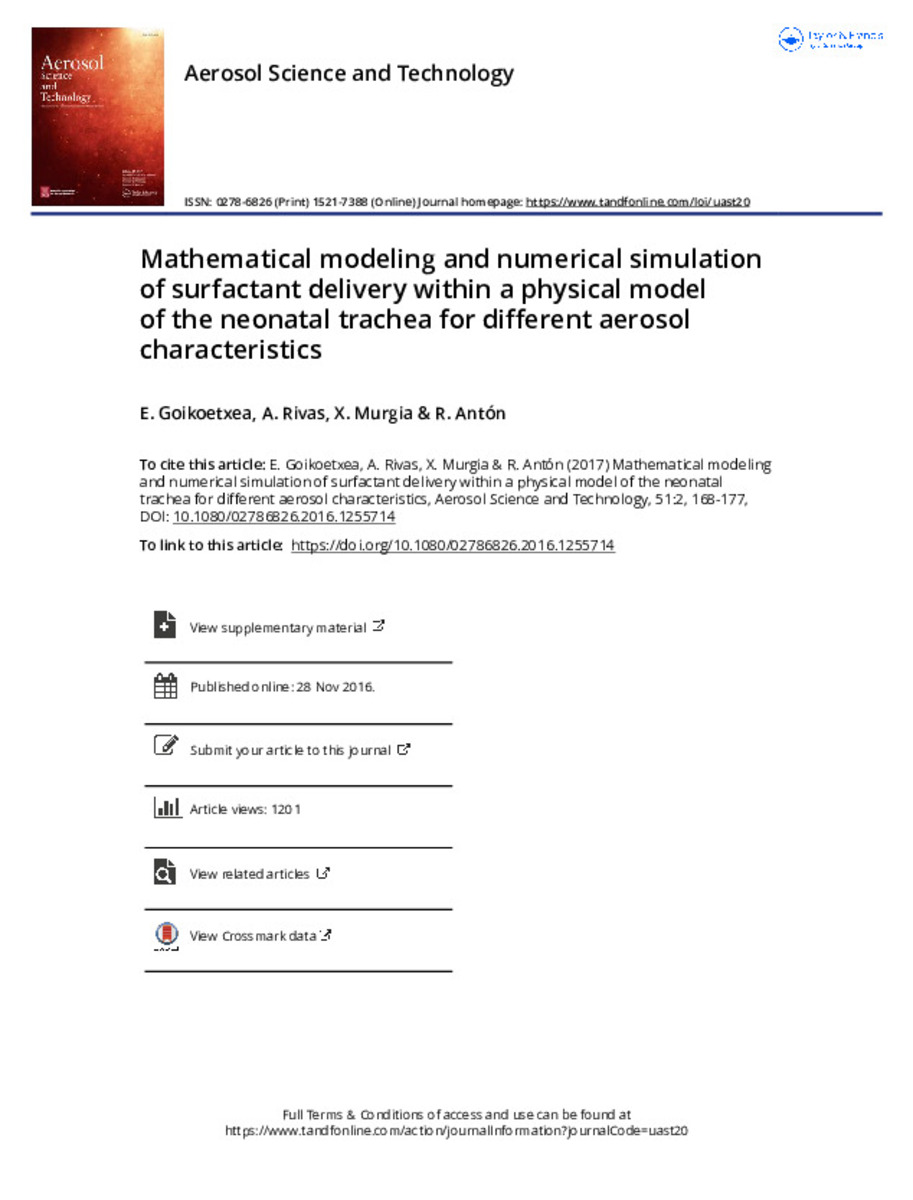Full metadata record
| DC Field | Value | Language |
|---|---|---|
| dc.creator | Goikoetxea-Miranda, E. (Estibalitz) | - |
| dc.creator | Rivas-Nieto, A. (Alejandro) | - |
| dc.creator | Murgia-Esteve, X.(Xabier) | - |
| dc.creator | Antón-Remírez, R. (Raúl) | - |
| dc.date.accessioned | 2024-02-05T13:04:10Z | - |
| dc.date.available | 2024-02-05T13:04:10Z | - |
| dc.date.issued | 2017-03 | - |
| dc.identifier.citation | Goikoetxea, E., Rivas, A., Murgia, X., & Antón, R. (2017). Mathematical modeling and numerical simulation of surfactant delivery within a physical model of the neonatal trachea for different aerosol characteristics. Aerosol Science and Technology, 51(2), 168-177. | es_ES |
| dc.identifier.issn | 0278-6826 | - |
| dc.identifier.uri | https://hdl.handle.net/10171/68790 | - |
| dc.description.abstract | Surfactant aerosol delivery in conjunction with a noninvasive respiratory support holds the potential to treat neonatal respiratory distress syndrome in a safe manner. The objective of the present study was to gain knowledge in order to optimize the geometry of an intracorporeal inhalation catheter and improve surfactant aerosol delivery effectiveness in neonates. Initially, a mathematical model capable of predicting the aerosol flow generated by this inhalation catheter within a physical model of the neonatal trachea was implemented and validated. Subsequently, a numerical study was performed to analyze the effect of the aerosol liquid droplet size and mass flow rate on surfactant delivery and on the required aerosolization time period. Experimental validation of the mathematical model showed a close prediction of the air axial velocity at the distal end of the physical model, with an absolute error between 0.01 and 0.15 m/s. Furthermore, an admissible absolute error between 0.2 and 2 mm was attained in the prediction of the aerosol mean aerodynamic diameter and mass median aerodynamic diameter in this region. The numerical study highlighted the beneficial effects of generating an intracorporeal aerosol with a mass median aerodynamic diameter higher than 4 mm and a surfactant mass flow rate above 8.93 mg/s in order to obtain effective surfactant delivery in neonates with minimal airway manipulation. | es_ES |
| dc.description.sponsorship | The authors would like to acknowledge the support of the Cátedra Fundación Antonio Aranzábal-Universidad de Navarra. | es_ES |
| dc.language.iso | eng | es_ES |
| dc.publisher | Taylor & Francis | es_ES |
| dc.rights | info:eu-repo/semantics/openAccess | es_ES |
| dc.subject | Respiratory-distsress-syndrome. | es_ES |
| dc.subject | In-silico models. | es_ES |
| dc.subject | Preterm infants. | es_ES |
| dc.subject | Open label. | es_ES |
| dc.subject | Deposition. | es_ES |
| dc.subject | Ventilation. | es_ES |
| dc.subject | Inhalation. | es_ES |
| dc.subject | Therapy. | es_ES |
| dc.title | Mathematical modeling and numerical simulation of surfactant delivery within a physical model of the neonatal trachea for different aerosol characteristics | es_ES |
| dc.type | info:eu-repo/semantics/article | es_ES |
| dc.editorial.note | CC BY | es_ES |
| dc.identifier.doi | 10.1080/02786826.2016.1255714 | - |
Files in This Item:
Statistics and impact
Items in Dadun are protected by copyright, with all rights reserved, unless otherwise indicated.






